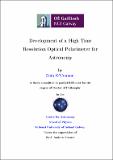| dc.contributor.advisor | Shearer, Andrew | |
| dc.contributor.author | O'Connor, Eoin | |
| dc.date.accessioned | 2019-02-04T09:19:48Z | |
| dc.date.available | 2019-02-04T09:19:48Z | |
| dc.date.issued | 2018-12-17 | |
| dc.identifier.uri | http://hdl.handle.net/10379/14897 | |
| dc.description.abstract | This work started in September, 2014 and initially started as an investigation of
the characterisation issues associated with using Electron Multiplying Charge-
Coupled Devices (EMCCDs) in a two beam polarimeter. It was necessary to
undertake a work placement with Andor Technology Ltd. (Belfast) in 2015 to
carry out testing and characterisation of CMOS and CCD sensors and to investigate
how they could be integrated as imaging sensors with the GASP instrument.
EMCCDs were selected due to their low noise performance under low light level
conditions and the GASP instrument has been used over the duration of this
work on three different telescopes, namely: the William Herschel Telescope in
La Palma in December 2015, the Observatoire de Haute-Provence (OHP) 1.93m
telescope in September 2017 and the La Silla Observatory 3.6m Telescope in
February 2018. The main initial design and fabrication work on the retarding
beamsplitting (RBS) prism was undertaken previously in NUI Galway. The work
contained in this thesis concerns a total mechanical redesign of the GASP instrument
to achieve the aim of realising the polarimeter as a usable instrument,
retaining only the RBS prism from this prior work.
The optical design of the GASP instrument is discussed and is shown exactly
as was used on the observing campaign at the 3.6m Telescope in La Silla. An
overview of the timing and electronic control hardware as used on that observing
campaign are also presented. A step by step outline of the calibration and characterisation
procedure which underlies the data reduction processes used by the
Galway Astronomical Stokes Polarimeter (GASP) instrument is also presented
and an analysis of the performance limitations of the instrument under usual
observing conditions.
Science results of the Crab pulsar, showing the performance and noise qualities
of the GASP polarimeter, using results obtained at the WHT in December 2015
are presented. These results give more of an understanding of the emission characteristics
of pulsars in the optical region of the spectrum and for the first time
the optical circular polarisation of a pulsar are presented. | en_IE |
| dc.publisher | NUI Galway | |
| dc.rights | Attribution-NonCommercial-NoDerivs 3.0 Ireland | |
| dc.rights.uri | https://creativecommons.org/licenses/by-nc-nd/3.0/ie/ | |
| dc.subject | Polarimetry | en_IE |
| dc.subject | Neutron Star | en_IE |
| dc.subject | Pulsars | en_IE |
| dc.subject | Optical Instrumentation | en_IE |
| dc.subject | Astronomy | en_IE |
| dc.subject | Physics | en_IE |
| dc.subject | Astronomy | en_IE |
| dc.title | Development of a high time resolution optical polarimeter for astronomy | en_IE |
| dc.type | Thesis | en |
| dc.contributor.funder | Irish Research Council | en_IE |
| dc.local.note | The Galway Astronomical Stokes Polarimeter (GASP) instrument is a two-beam optical polarimeter used to measure the polarisation of rapidly varying astronomical optical sources. It is used mostly to detect light from very faint stars. | en_IE |
| dc.local.final | Yes | en_IE |
| nui.item.downloads | 203 | |


